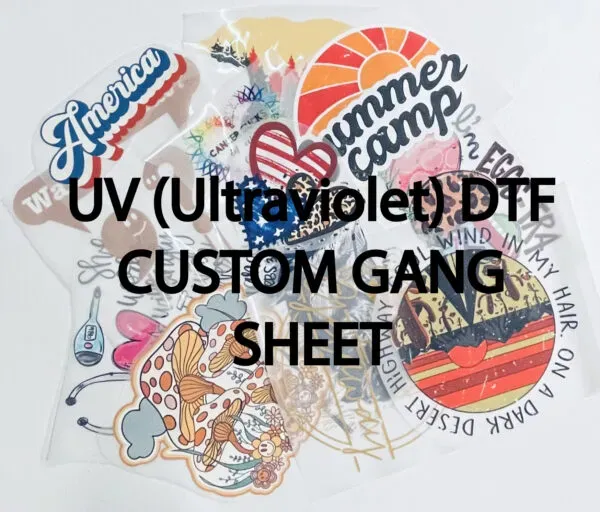UV DTF Gangheet technology is shaping the future of custom apparel printing with its unique ability to deliver high-quality prints while prioritizing sustainability. This innovative method utilizes ultraviolet light for curing inks on films, resulting in vibrant, durable, and precise designs that set a new standard in the apparel printing industry. As businesses and consumers alike seek more environmentally-friendly options, UV DTF printing emerges as a solution that combines efficiency, artistry, and reduced carbon footprints. By investing in cutting-edge DTF technology, custom apparel makers are not only enhancing their product offerings but also contributing to a more sustainable printing environment. The advancements seen in UV DTF Gangheet processes reflect the ongoing evolution of apparel printing innovations that cater to the demands of modern consumers.
In the realm of custom garment production, Direct-to-Film (DTF) printing, particularly through the Gangheet process, represents a groundbreaking advancement. This state-of-the-art approach leverages ultraviolet technology to efficiently cure inks, resulting in extraordinary print quality that elevates traditional methods to new heights. As sustainability becomes a critical factor in consumer choices, the embrace of eco-friendly practices within DTF printing highlights a shift towards responsible production. Moreover, with the versatility of materials this technology affords, designers now have a broader canvas for creativity and customization in their apparel lines. As a result, the landscape of custom apparel is being transformed, paving the way for innovative solutions that meet both aesthetic and ecological standards.
The Rise of Custom Apparel Printing Innovations
Custom apparel printing has undergone significant transformations with the advent of advanced technologies. Innovations like UV DTF (Direct-to-Film) technology are setting new benchmarks in the industry. This method allows for unparalleled precision and vibrant color reproduction, which traditional printing techniques often cannot achieve. As a result, brands and businesses are increasingly drawn to custom apparel printing for its ability to fulfill modern consumer demands for uniqueness and quality.
Furthermore, the rise of digital printing technologies has democratized the ability to create custom designs. Brands can now easily bring artistic visions to life, ranging from personalized t-shirts to complex patterns on hoodies. This ability not only caters to individual preferences but also supports the rapid turnaround times that today’s fast-paced market requires.
Frequently Asked Questions
What is UV DTF printing and how does it work in custom apparel printing?
UV DTF (Direct-to-Film) printing is a modern printing technology that uses ultraviolet light to cure inks as they are printed onto films. These films can then be transferred onto various fabrics, resulting in vibrant, high-quality prints that are durable and precise. This method is revolutionizing custom apparel printing by allowing for creative designs and efficient production.
How does UV DTF Gangheet technology contribute to sustainable printing practices?
UV DTF Gangheet technology supports sustainable printing by minimizing waste with eco-friendly inks and efficient printing processes. Unlike traditional methods that can lead to harmful emissions and excess materials, UV DTF utilizes inks that are more sustainable, resulting in a lower carbon footprint for custom apparel production.
What are the benefits of using UV DTF technology for apparel printing innovations?
The benefits of UV DTF technology in apparel printing include enhanced print quality, the ability to print on various materials, and faster production times. These innovations allow businesses to meet increasing consumer demands for high-quality, personalized garments efficiently, setting them apart in the competitive custom apparel market.
Can UV DTF printing fulfill the growing demand for personalized fashion and custom designs?
Yes, UV DTF printing is ideally suited to meet the growing demand for personalized fashion. It allows custom shops to produce intricate and unique designs quickly, enhancing consumer satisfaction and enabling businesses to cater to diverse preferences in custom apparel.
What role does UV DTF printing play in enhancing operational efficiency for custom apparel businesses?
UV DTF printing enhances operational efficiency by streamlining the printing process and reducing setup times. This results in quicker turnarounds for custom orders, allowing businesses to efficiently respond to consumer demands and capitalize on trends in the fast-paced fashion industry.
How does UV DTF technology affect consumer expectations in the custom apparel market?
As UV DTF technology becomes more prevalent, consumer expectations for custom apparel have risen. Shoppers now anticipate high-quality, unique products that reflect their individual styles. This demand drives businesses to innovate continuously and improve their offerings, ensuring they remain competitive in the evolving market.
| Key Points | Details |
|---|---|
| Introduction | UV DTF technology is transforming custom apparel with sustainability, technological innovations, and market impact. |
| Understanding UV DTF Printing | Utilizes ultraviolet light for high-quality, durable prints on various materials. |
| Sustainability Benefits | Eco-friendly inks and efficient printing processes minimize waste and carbon footprint. |
| Technological Innovations | High-capacity printers enable same-day shipping and improve print quality. |
| Market Impact | Increased accessibility for artists and enhanced consumer expectations for unique products. |
| Implications for Businesses | Adoption of UV DTF can expand service offerings and boost operational efficiency. |
Summary
UV DTF Gangheet is a pivotal technology that is reshaping the landscape of custom apparel printing. Through its innovative methods and sustainability-focused practices, UV DTF printing enhances production efficiency while aligning with the increasing consumer demand for unique and eco-friendly apparel. As more businesses embrace this technology, it not only fosters creativity but also supports a shift towards a more sustainable fashion industry. In conclusion, adopting UV DTF methods is not just a strategic business decision for apparel companies, but also a commitment to a greener future in fashion.

